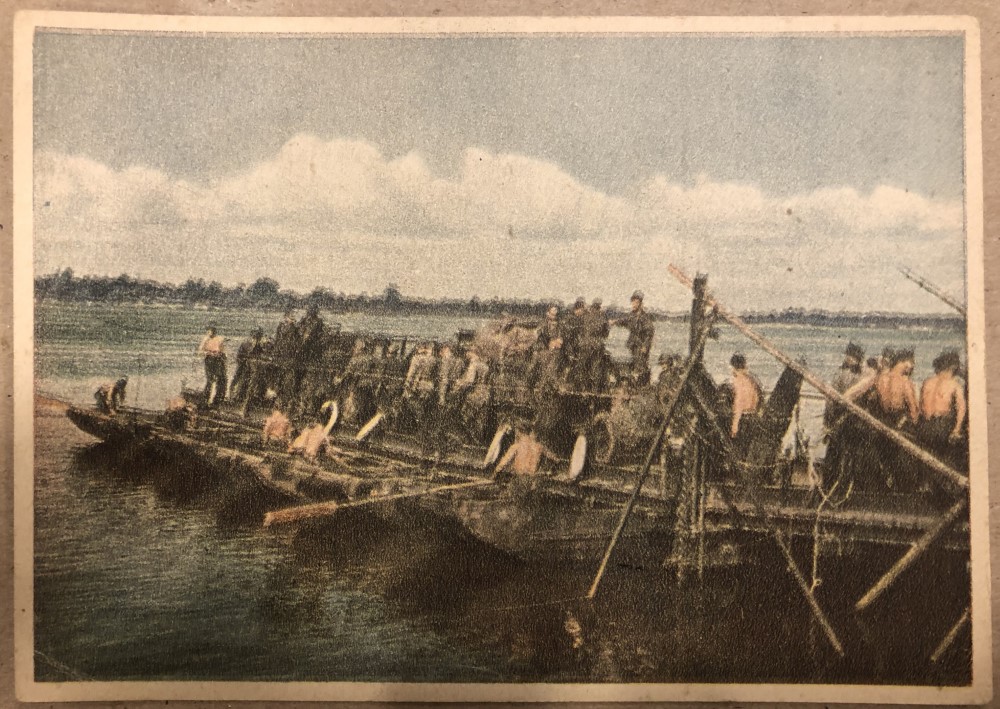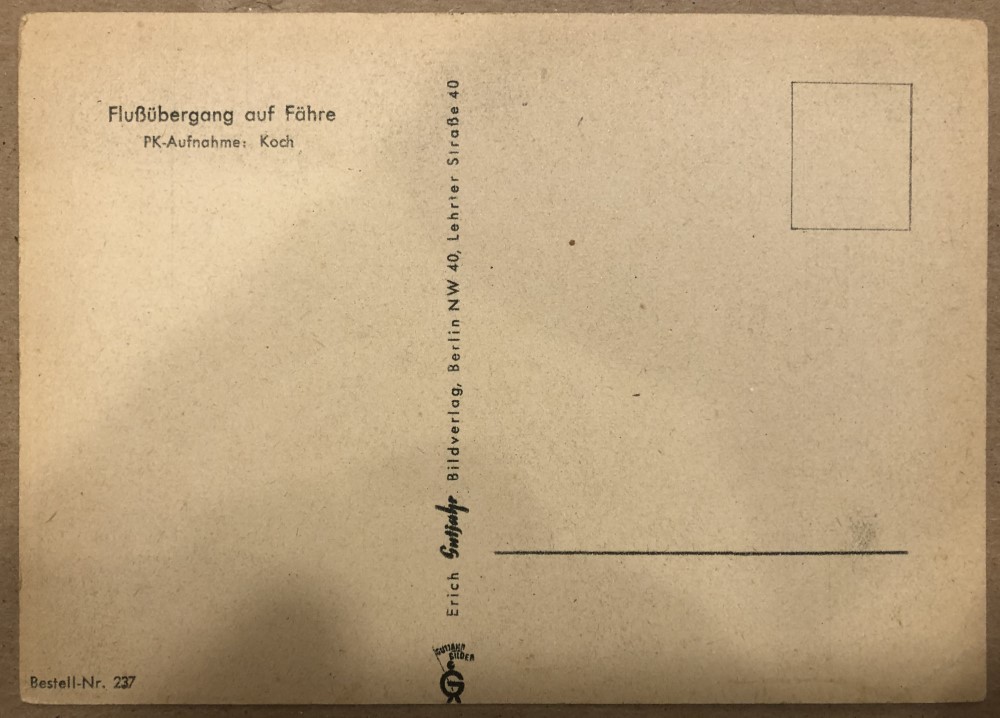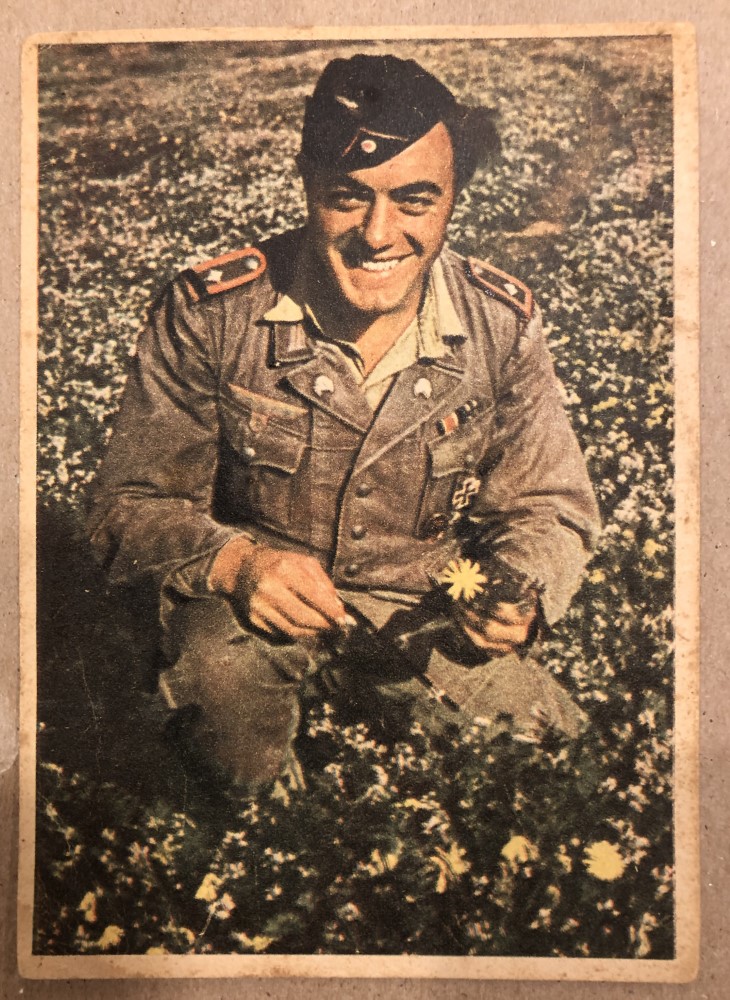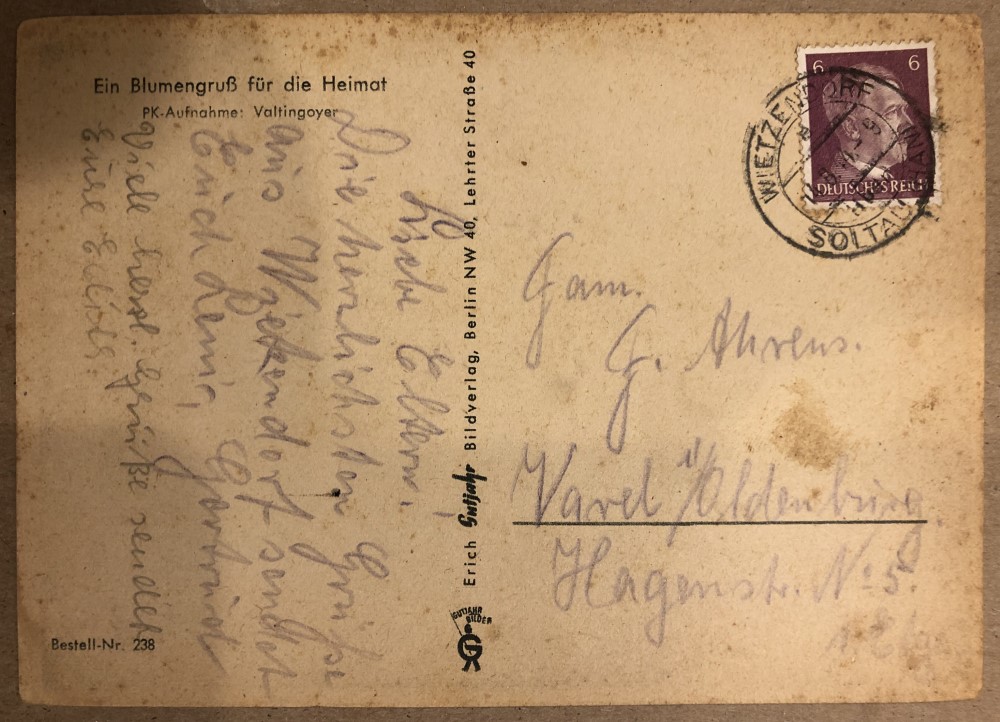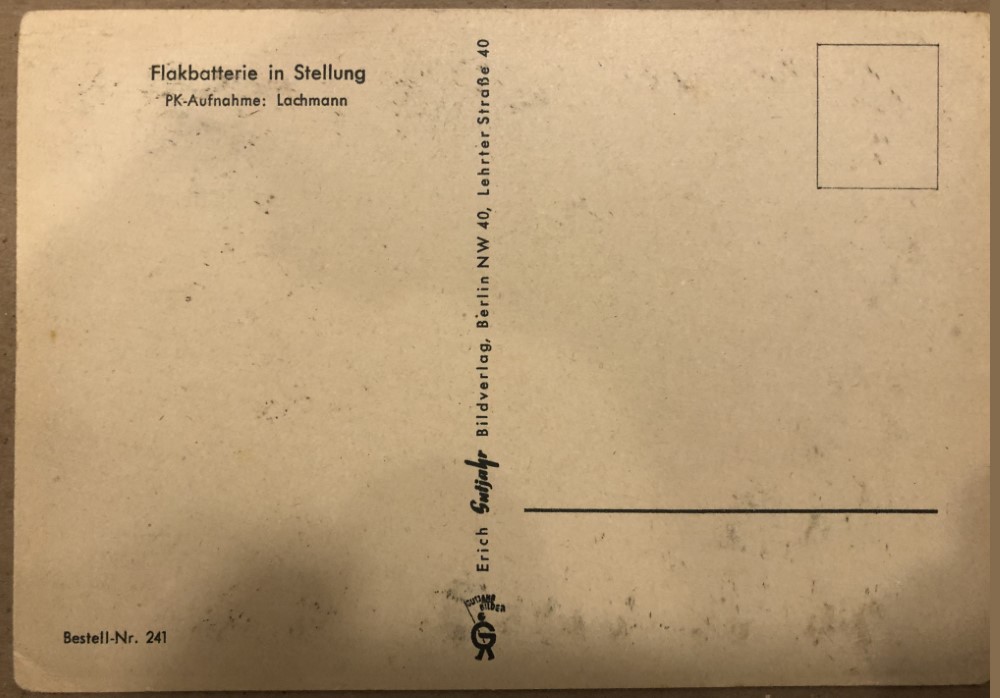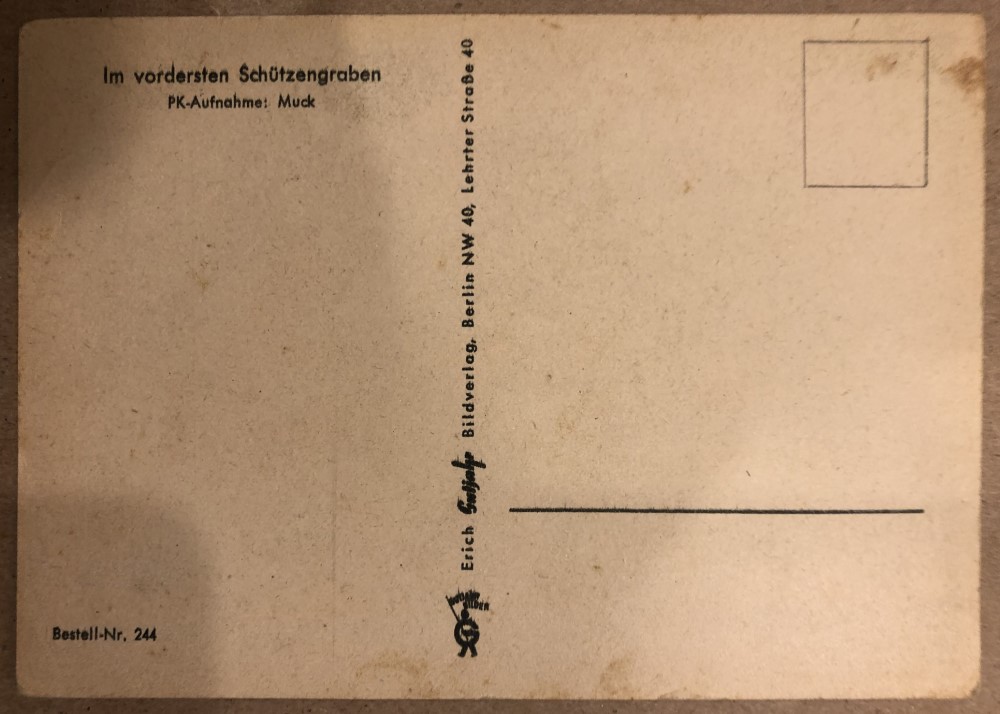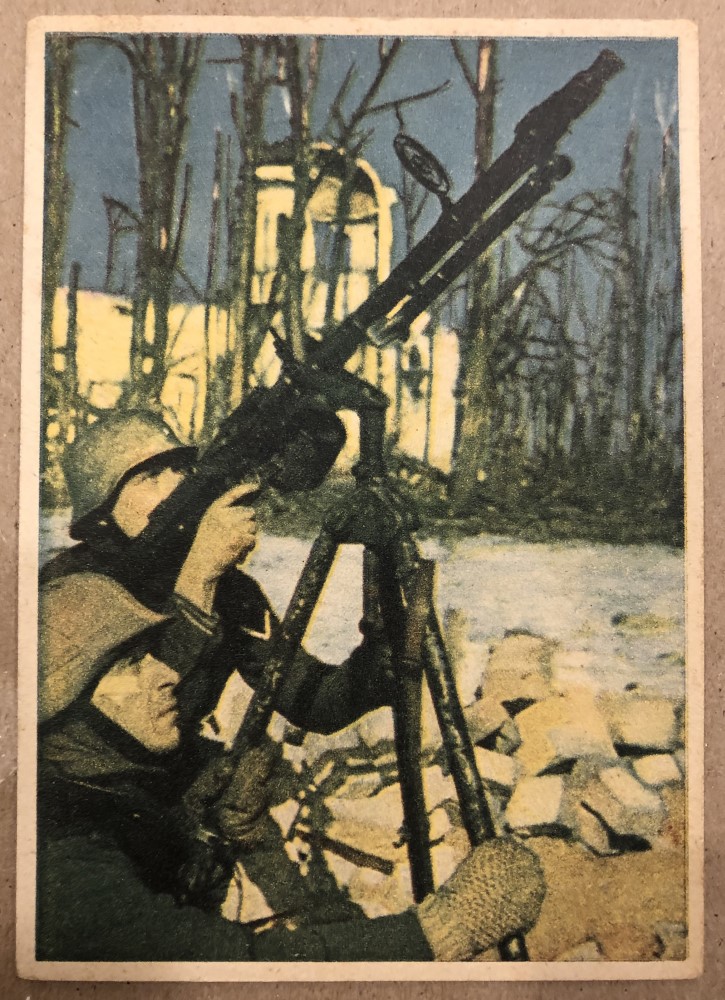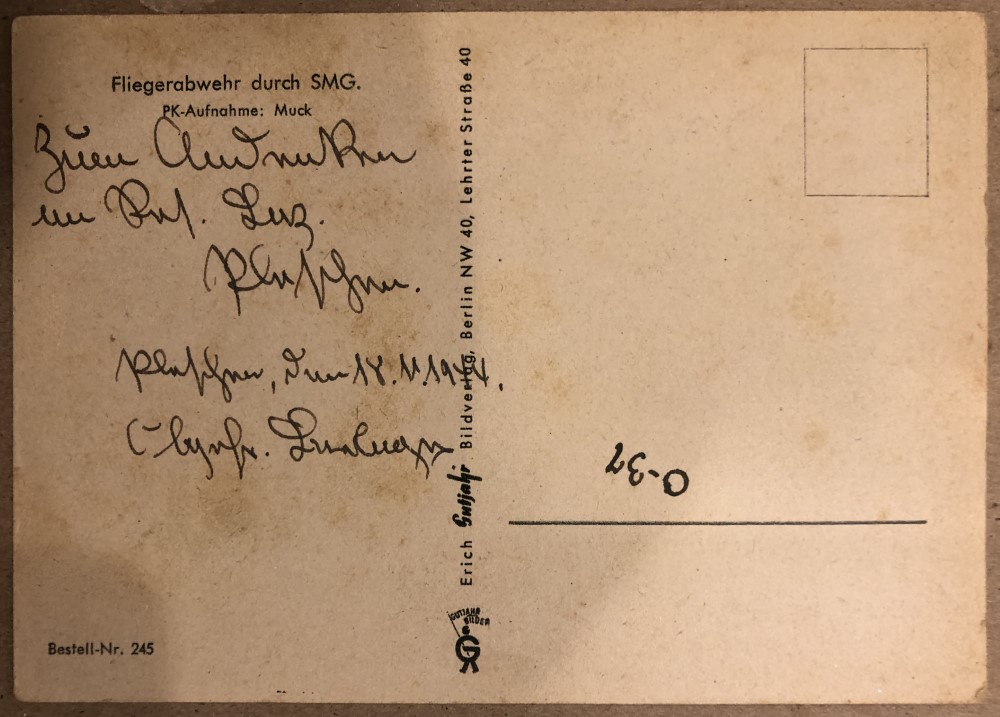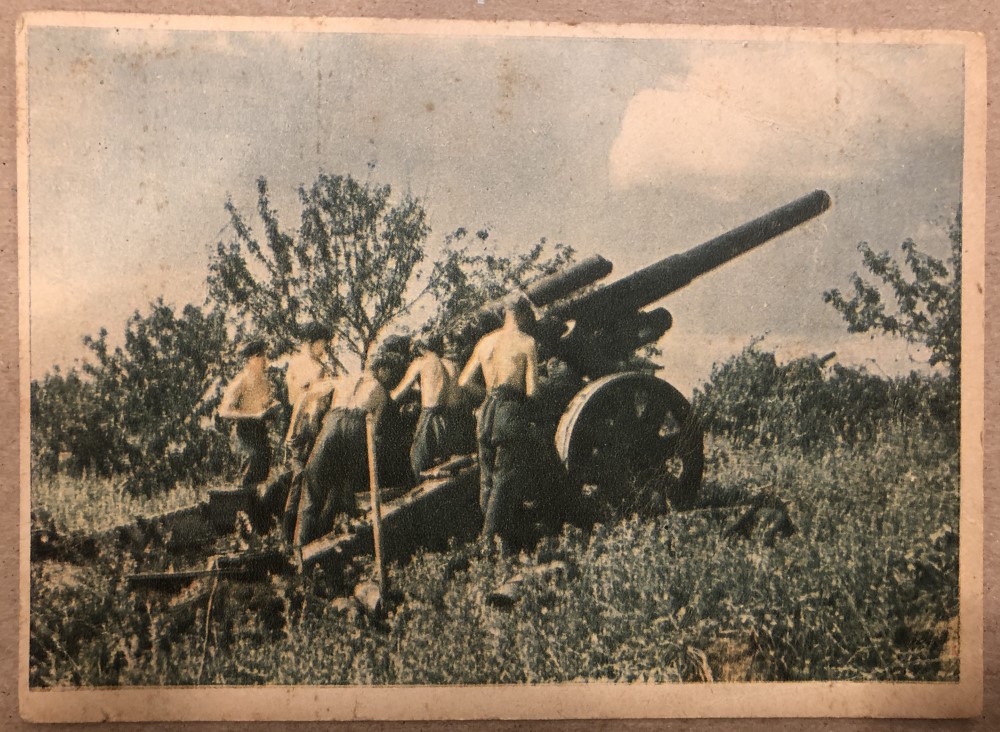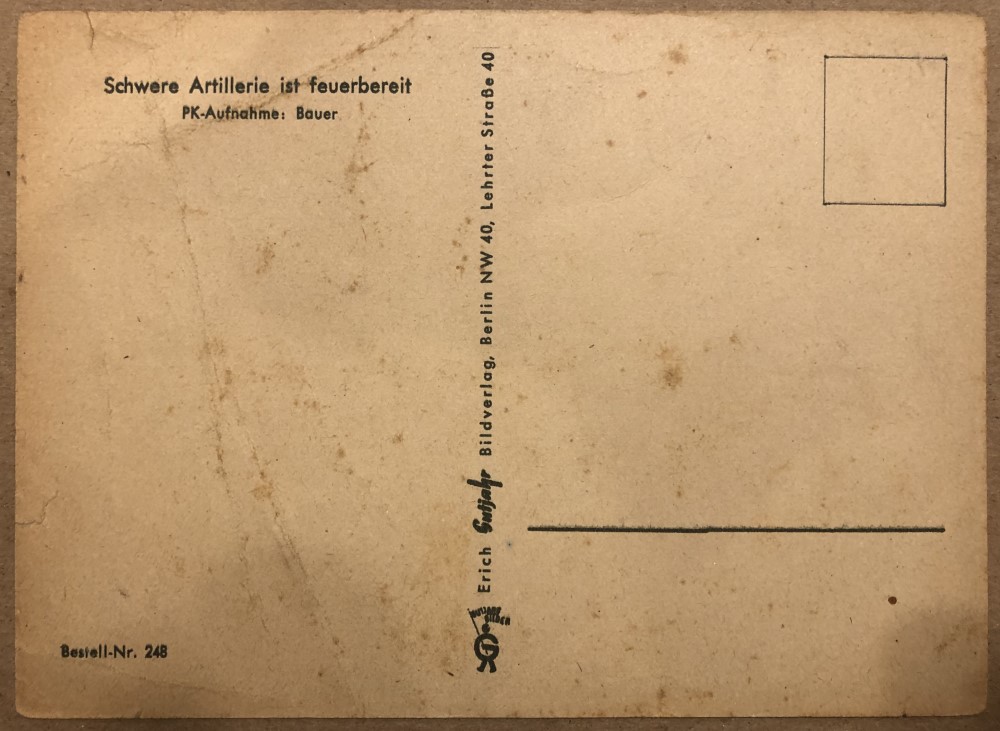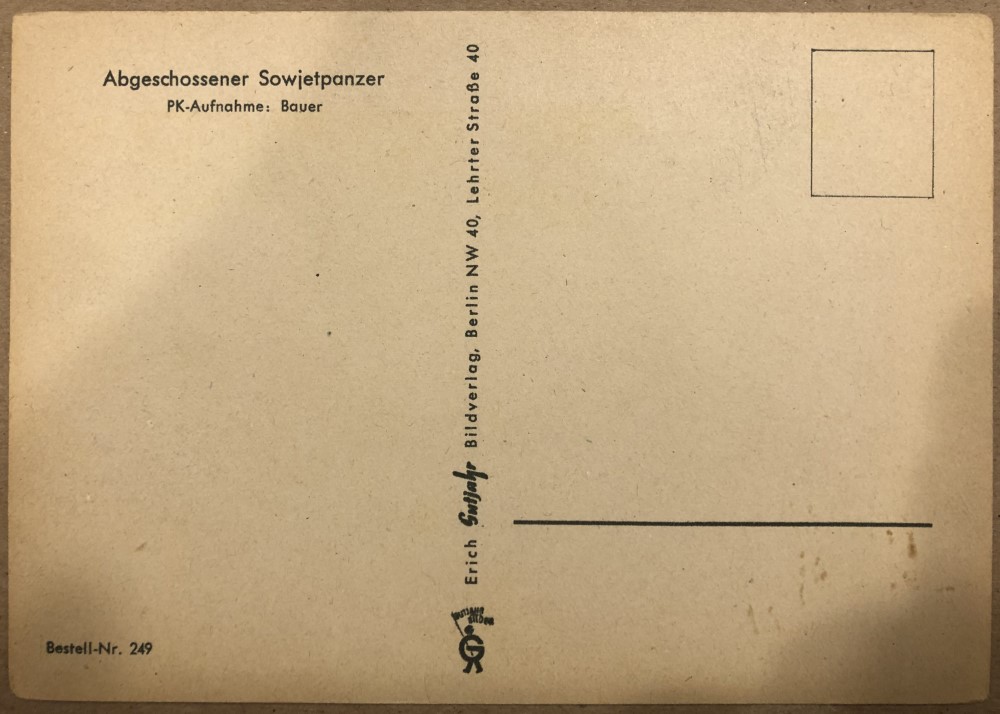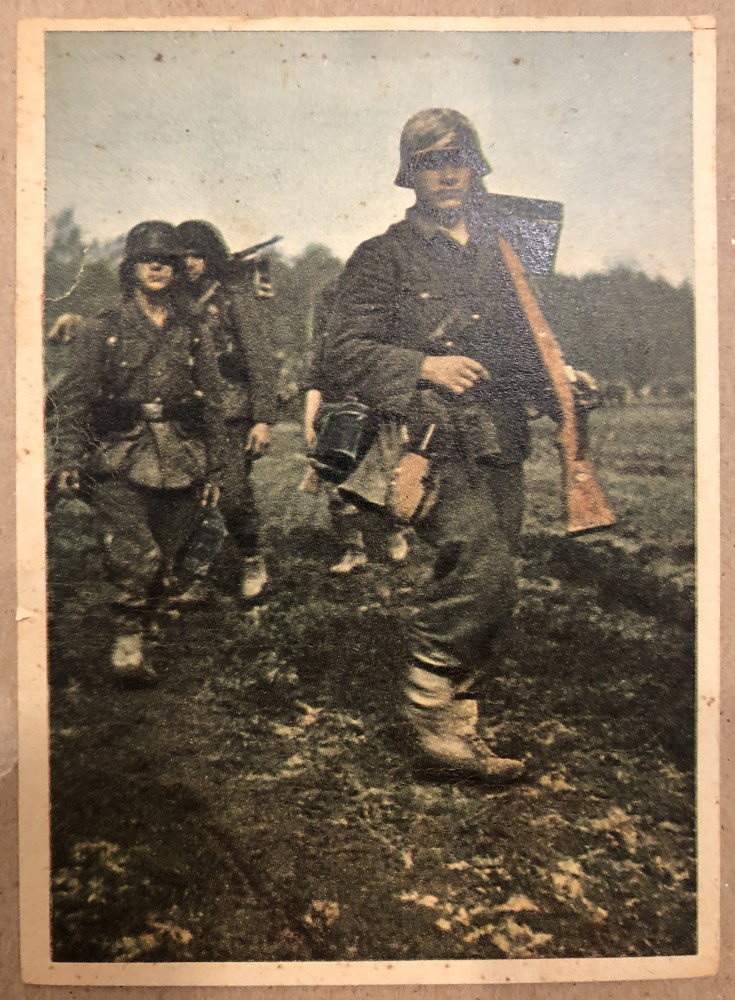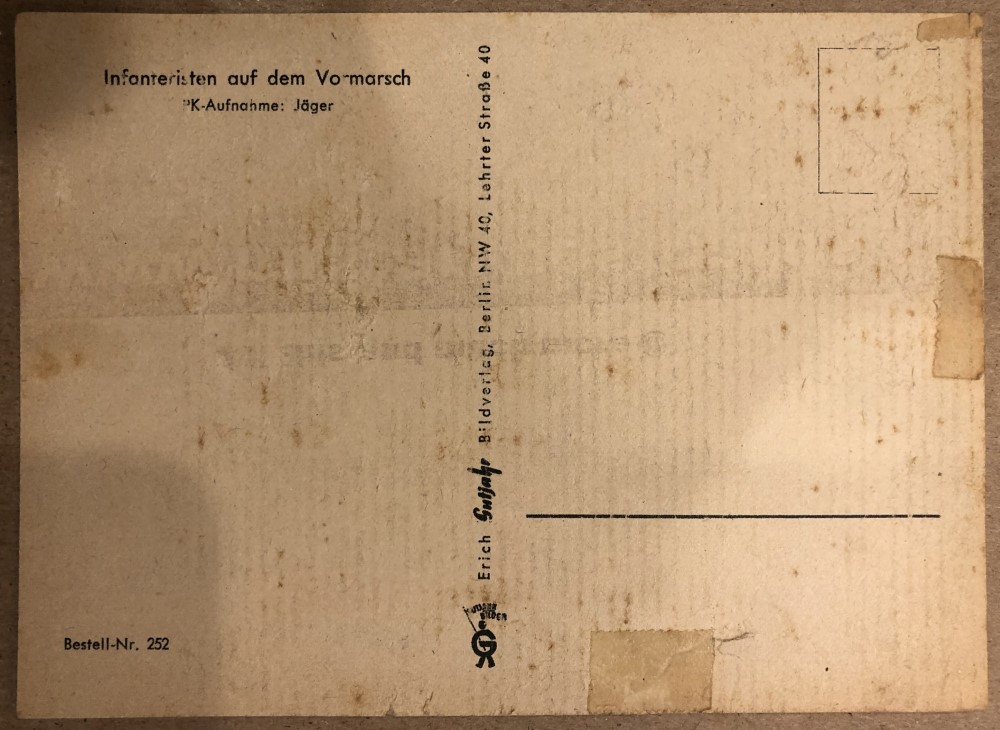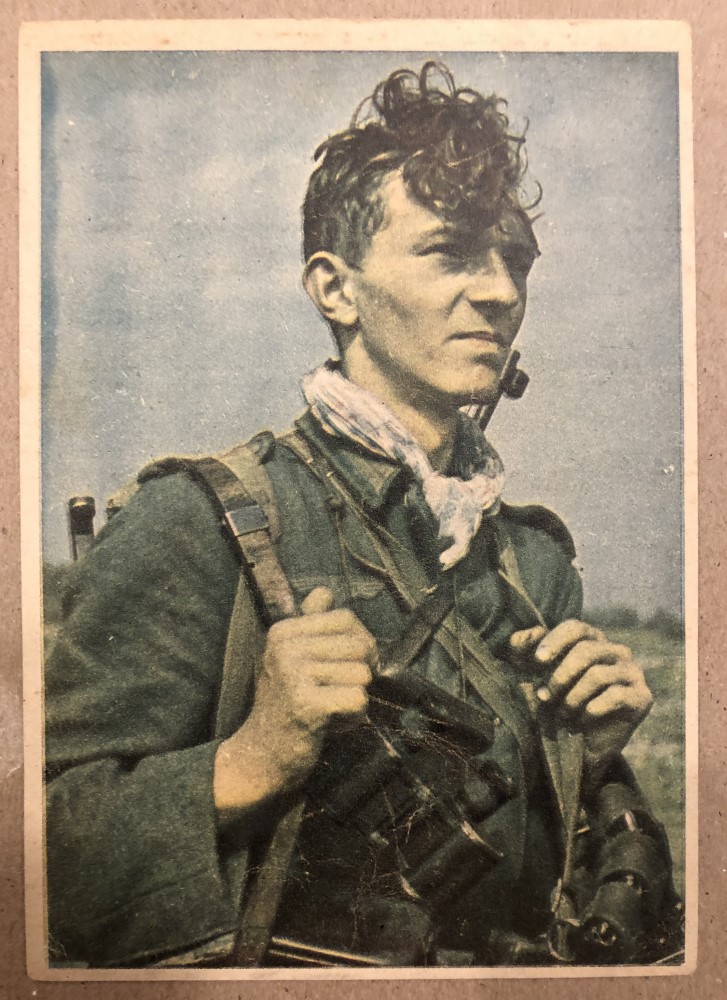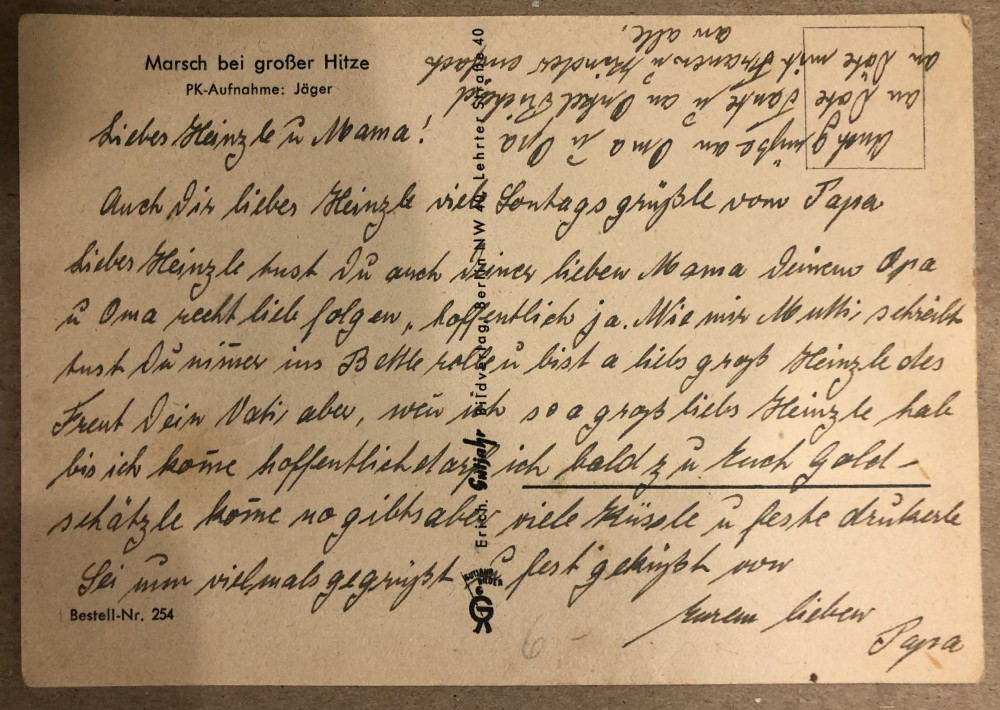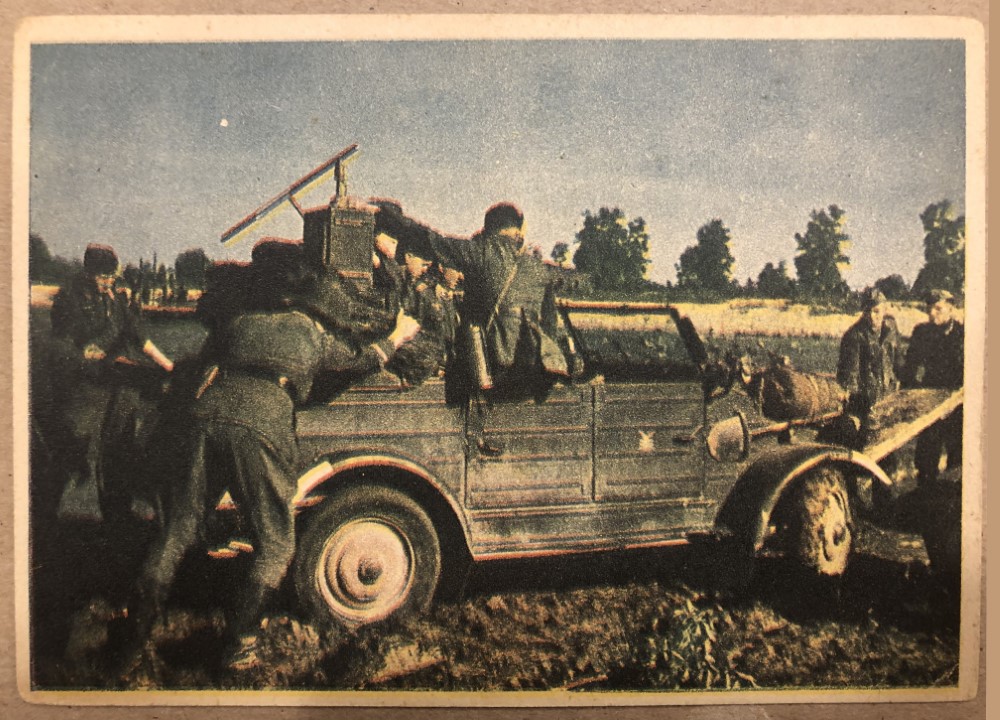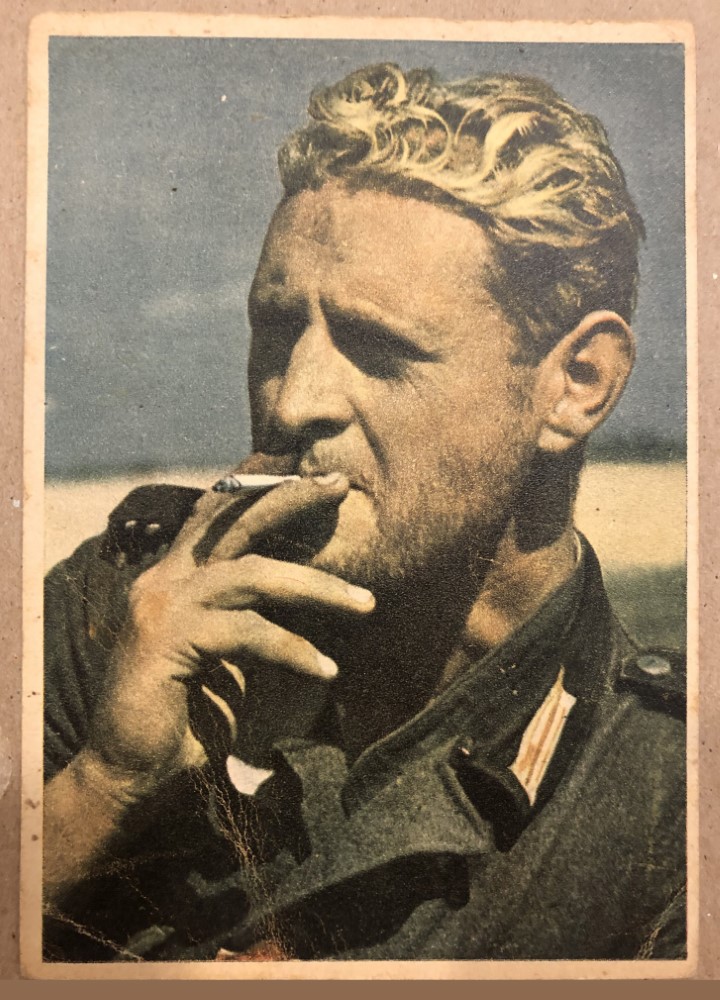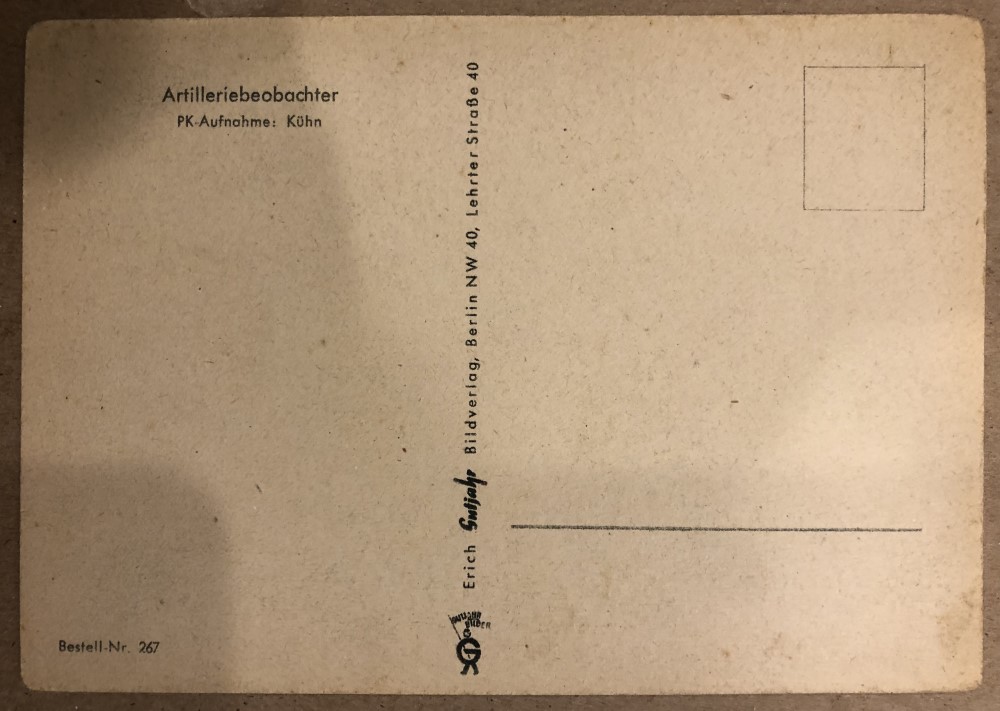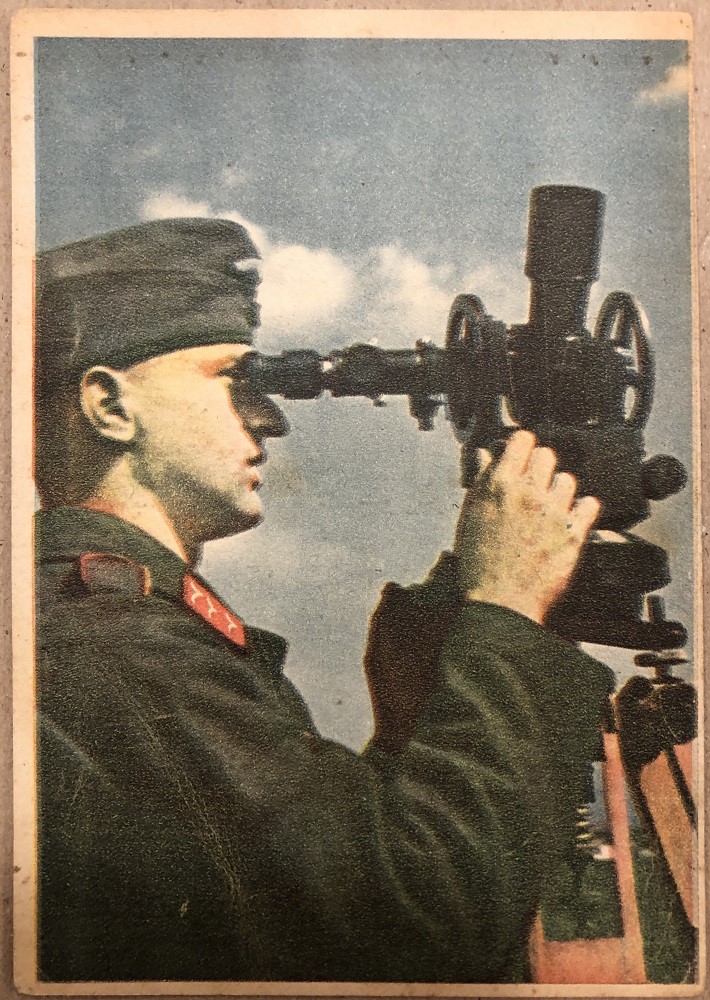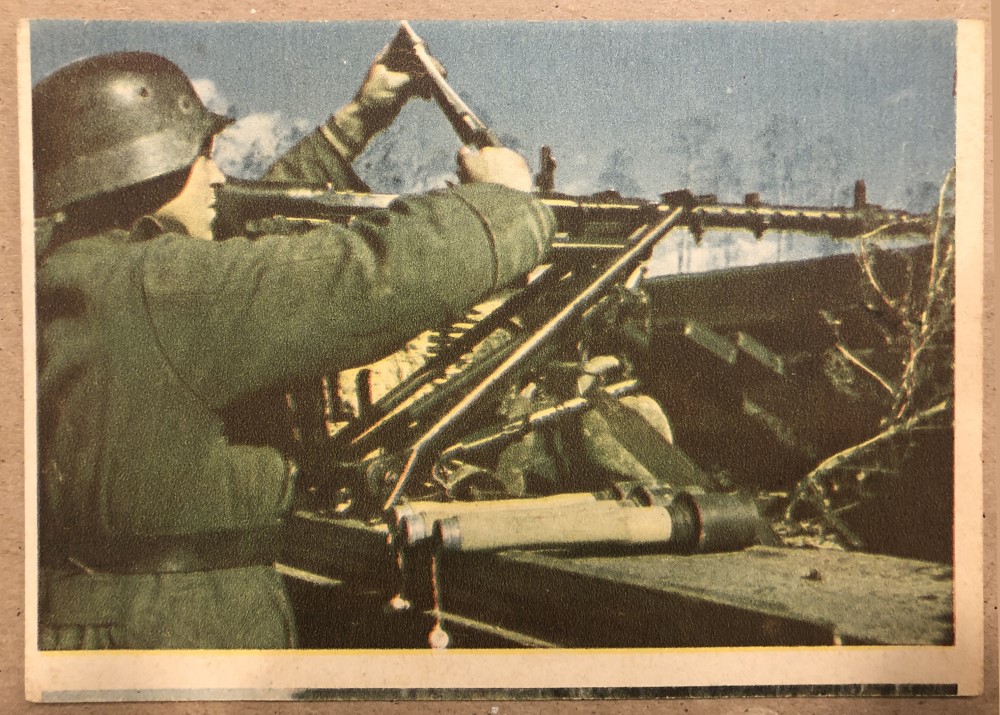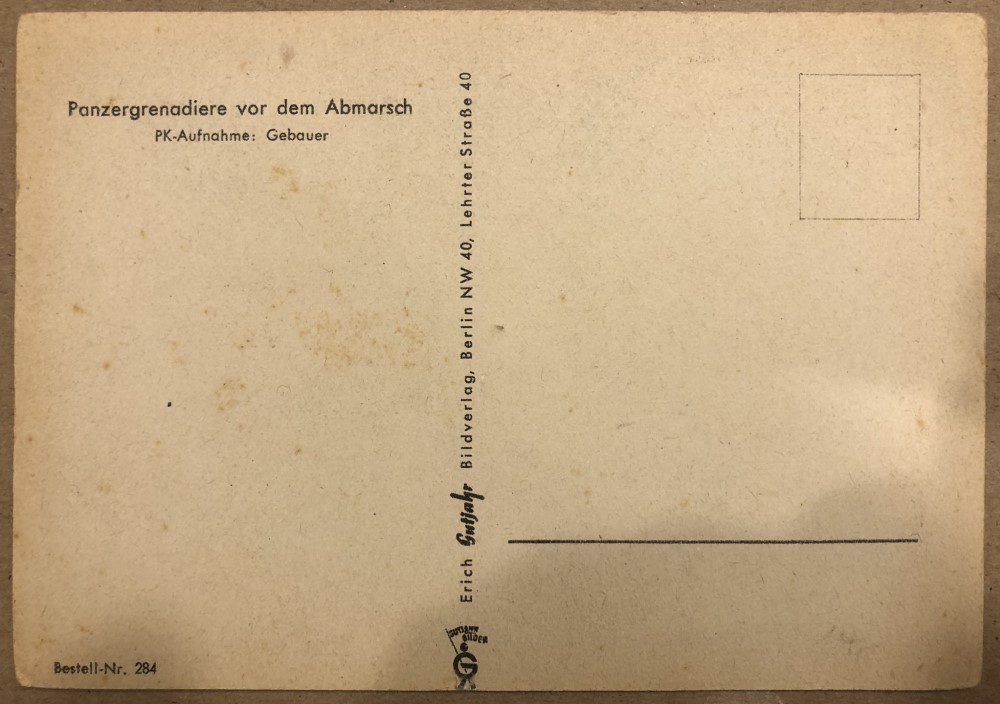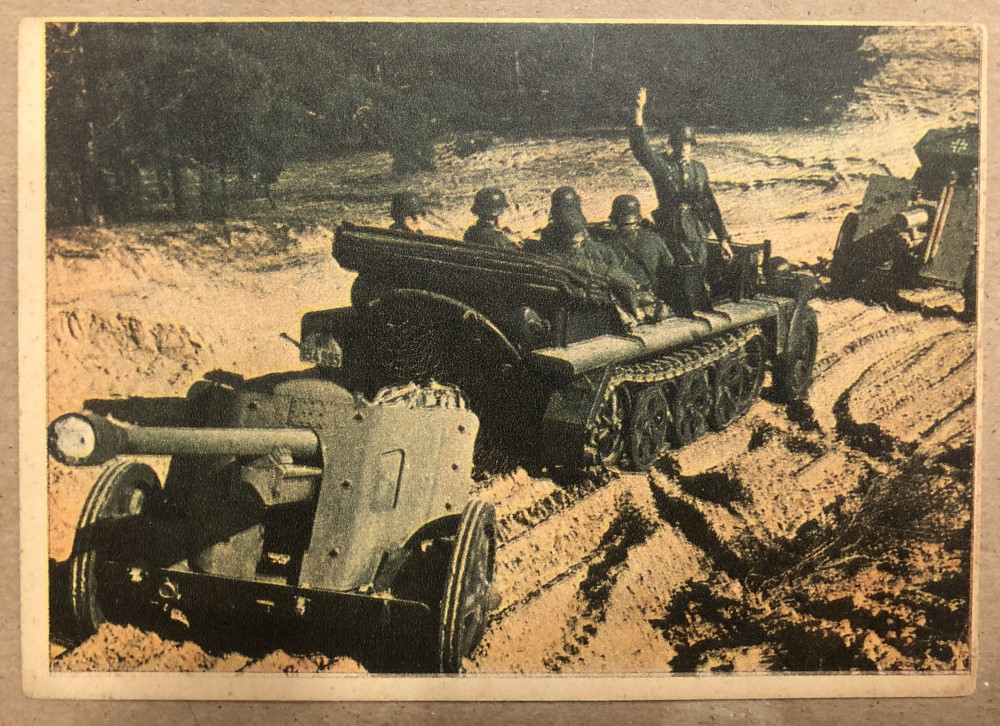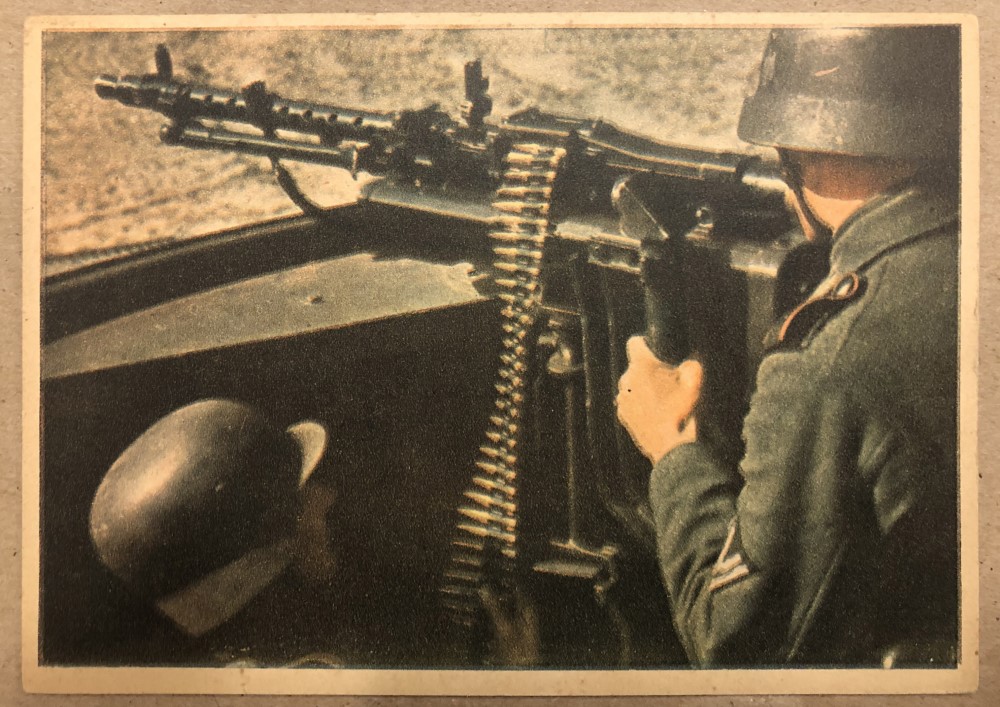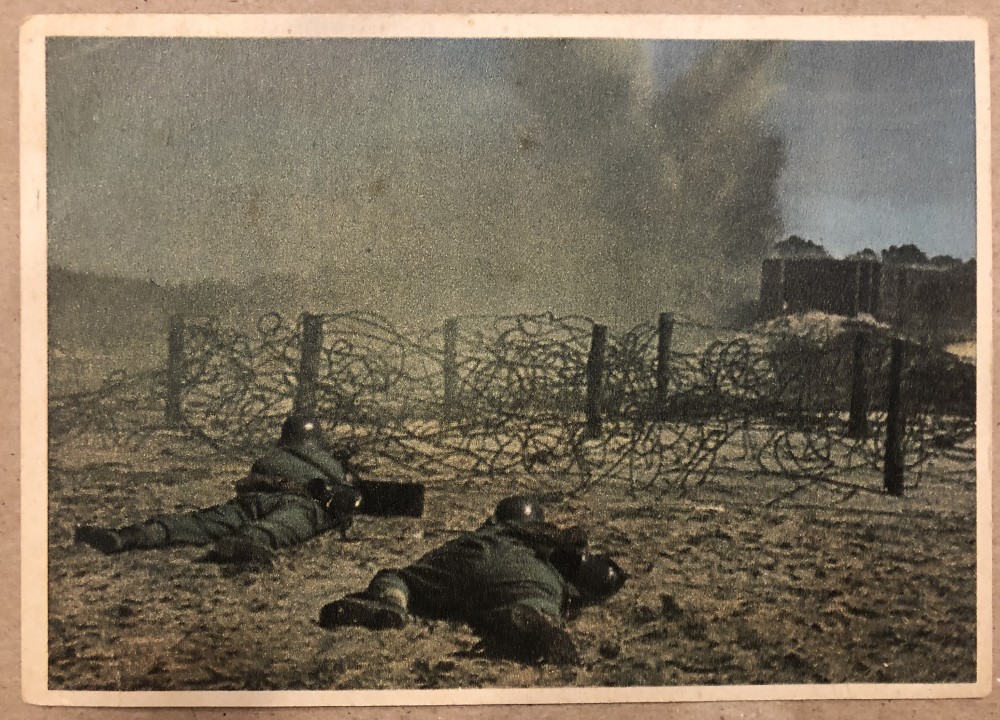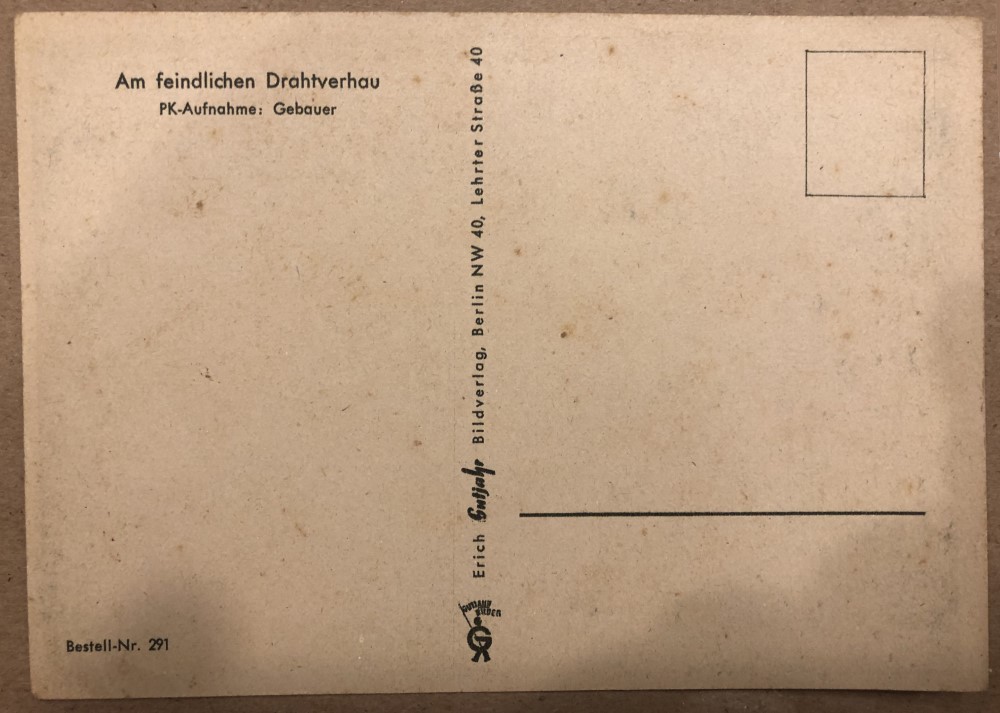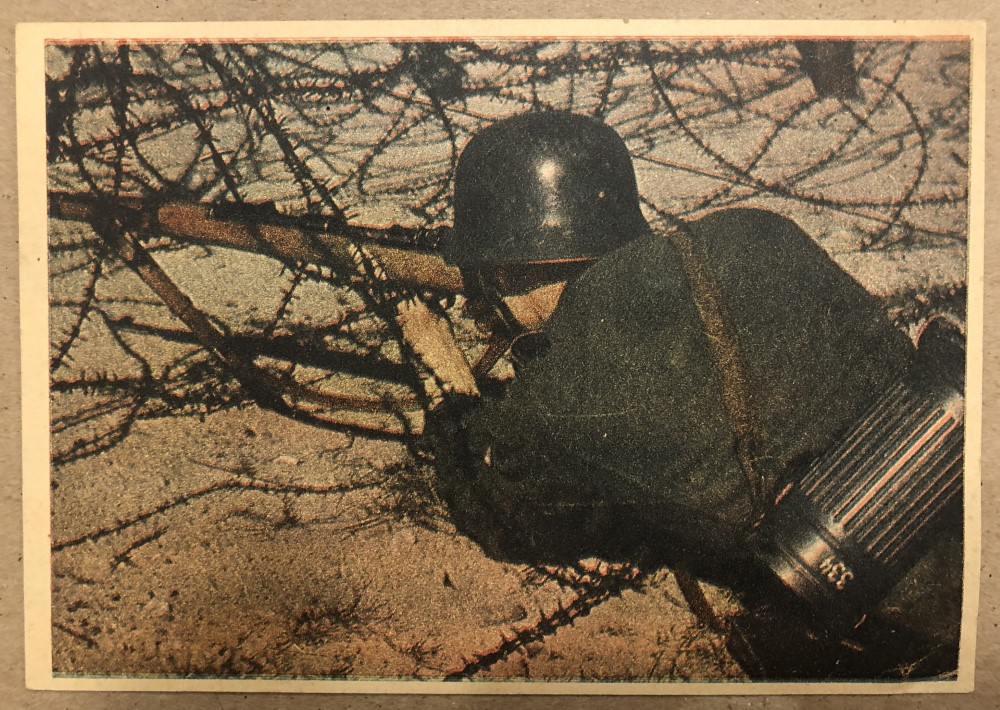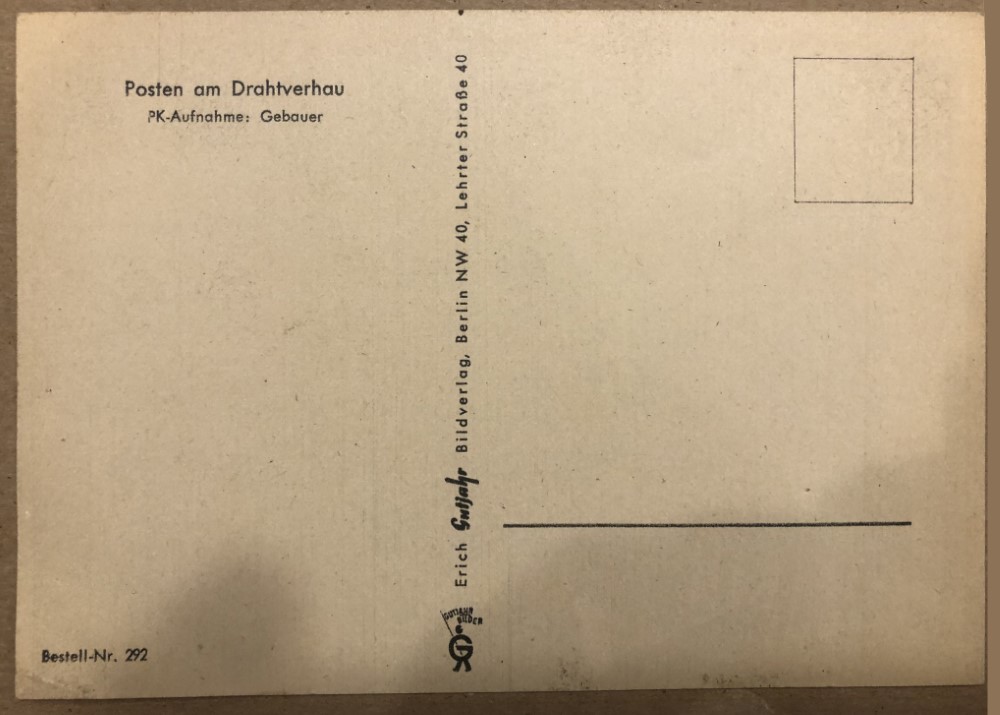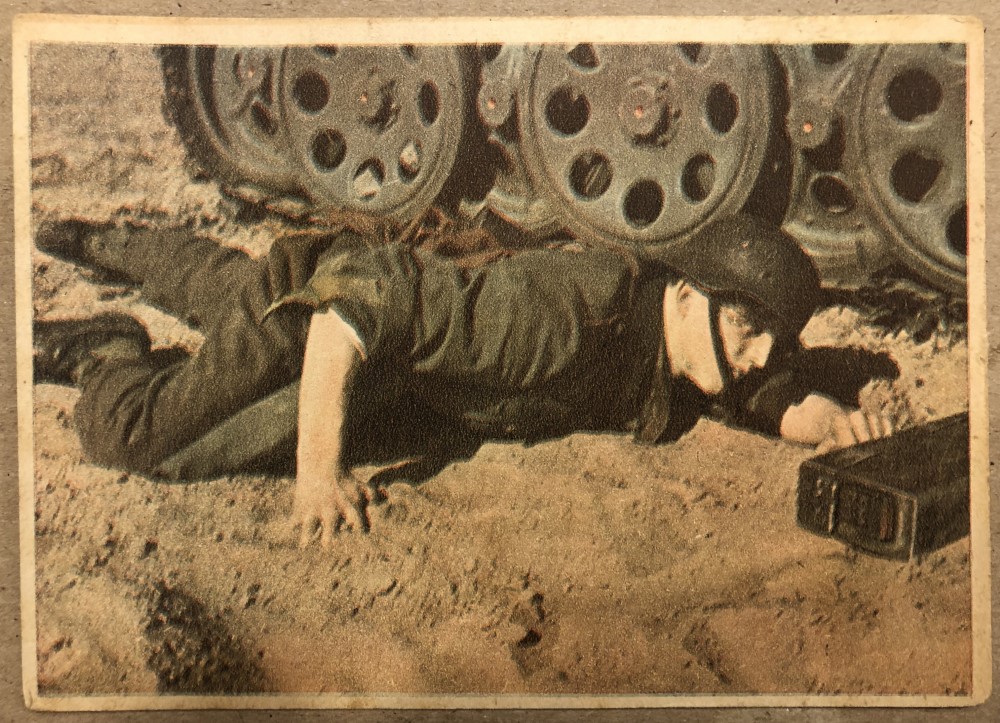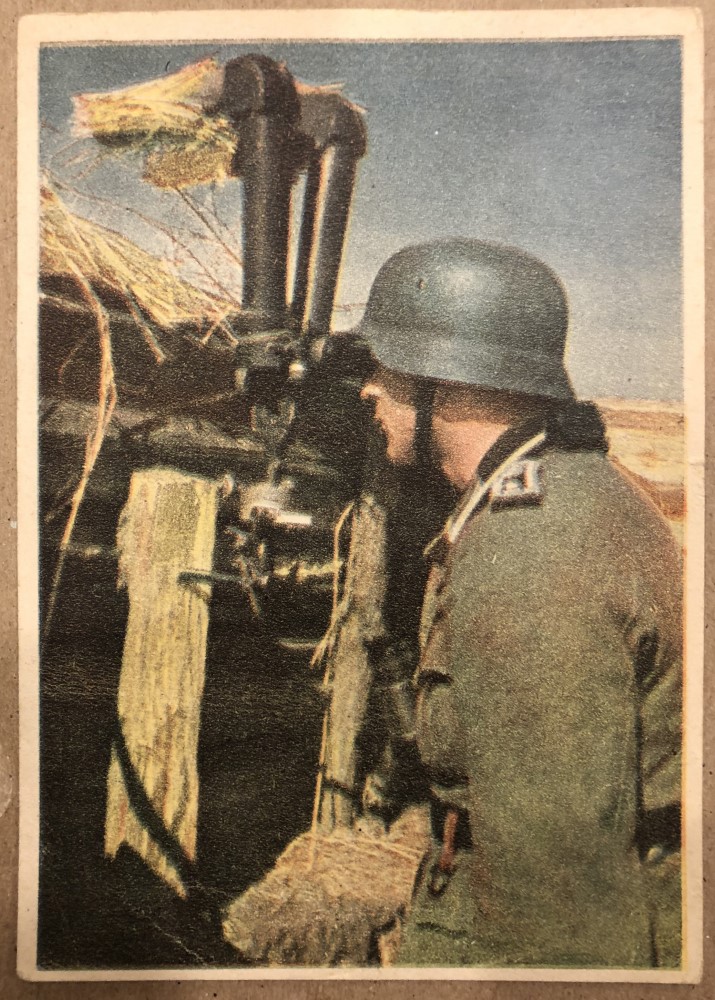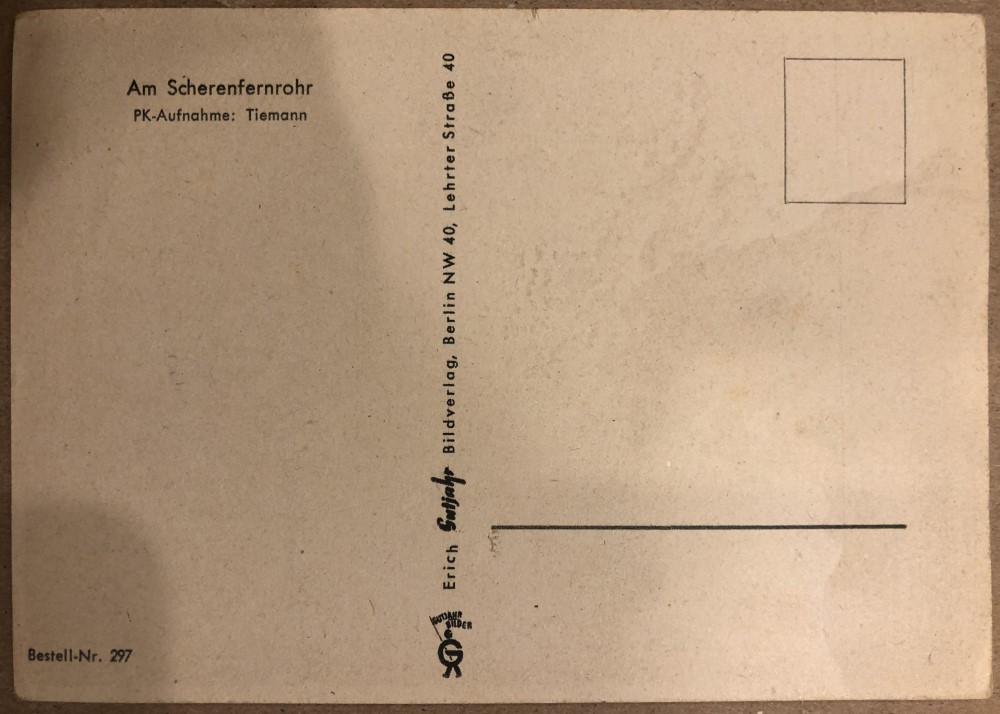ERICH GUTJAHR POSTCARDS

Erich Gutjahr Bildverlag was a publishing company located at Lehrter Strasse 40, Berlin NW 40 and was well-known for producing copious amounts of military related printed matter. Along the central dividing line of each card is the name of the Publisher, 'Erich Gutjar, Bildverlag, Berlin NW 40, Lehrter straβe 40'. On the reverse of the card there is a title and below that the name of the photographer.

WEHRMACHT
The following images were kindly submitted by Ed Stroh and I am very happy to be able to host this series of Erich Gutjahr postcards. Ed doesn't have the full set so if anyone can help fill in the gaps, we would both be happy to receive any scans you may have. Although the series is not titled, I have temporarily named it 'WEHRMACHT' (there are images of Heer and Luftwaffe troops on these cards).
Looking at the equipment used, uniforms worn and other factors leads me to believe these images were taken by embeded photographers (at least 15 of them) assigned to different units involved in the Russian campaign, from the start of Operation Barbarossa in Jun 1941 until the summer of 1942. They were likely made available to the German public as postcards a few months after this.

No. 237
Fluβübergang auf Fähre
By Koch
This card has the inscription 'Fluβübergang auf Fähre' and features German soldiers attempting to cross a river on a makeshift boat. The Russians implemented a 'scorched-earth' policy as they retreated deeper and deeper into Russia leaving as little as possible intact for the Germans. This included the destruction of bridges, buildings, farms and industrial areas, as well as the burning of crops and killing of livestock so as to leave nothing of use.
'River Crossing by Ferry'
No. 238
Ein Blumengruβ für die Heimat
By Valtingoyer
This card has the inscription 'Ein Blumengruβ für die Heimat' and features a German soldier taking time out to pick some flowers. Judging by the uniform, the Panzer Beret (Schutzmütze), the black shoulder straps with red piping, the collar insignia and the Totenkopf badges on his lapels, this enlisted 'obersoldat' appears to be an 'SS-Kannonier', a gunner in the Armed SS. In addition he is wearing the Iron Cross First Class on his left breast pocket and what looks to be a black wound badge, below and to the left of the Iron Cross.
A flower greeting for the home
No. 241
Flakbatterie in Stellung
By Lachmann
This card has the inscription 'Flakbatterie in Stellung' and depicts a Flak team awaiting the arrival of Russian aircraft. The gun appears to be a 3.7cm Anti-Aircraft gun (confirmation required). From 1936 until 1945 the Germans produced over 20,000 of these Rheinmetall guns, each requiring a crew of six or seven and capable of firing 160 rounds per minute a distance of 4,200 meters in anti-aircraft mode or 8,000 meters in anti-tank mode.
Flak Battery in Position
No. 244
Im vordersten Schützengraben
By Muck
This card has the inscription 'Im vordersten Schützengraben' and depicts two German soldiers defending their trenches during the cold Russian winter. This image as well as image No. 245 were both taken by photographer Richard Muck. A check on the Bundesarchiv website shows quite a few similar images taken by Muck in the Cholm Pocket at the beginning of 1942. Although neither of these images is there, they were most likely taken at the same time.
In the frontline trenches
No. 245
Fliegerabwehr durch SMG
By Muck
This card has the inscription 'Fliegerabwehr durch SMG' and depicts a German gefreiter (lance Corporal) aiming his weapon at enemy aircraft. His MG34 Machine gun has been mounted on a tripod to help stabilise it as it is being used as an anti-aircraft weapon rather than the more common ground support role.
Air defense by SMG
No. 248
Schwere Artillerie ist Feuerbereit
By Bauer
This card has the inscription 'Schwere Artillerie ist Feuerbereit' and depicts a 15cm schwere Feldhaubitze 18 or sFH 18 (Immergrün or Evergreen) [Requires confirmation] team in operation in the hot Russian summer.
The sFH 18 was one of the most important weapons available to the German infantry, however it was not very effective against the Russians who had several guns that had better performance (the A-19 and ML-20). A total of 6,756 examples were produced from 1934 until the end of the war. The gun required a crew of 7 and could fire 4 rounds per minute for a maximum range of 13,325 meters.
Heavy artillery is ready to fire
No. 249
Abgeschossener Sowjetpanzer
By Bauer
This card has the inscription 'Abgeschossener Sowjetpanzer' and depicts a destroyed Soviet tank.
Destroyed Soviet Tank
No. 252
Infanteristen auf dem Vormarsch
By Jäger
This card has the inscription 'Infanteristen auf dem Vormarsch' and depicts German soldiers advancing through a Russian field. The soldier on the right is carrying a regular issue Karabiner 98K, the standard service rife of the Wehrmacht, and developed by the Mauser Company. The rifle was introduced in 1935 and was used throughtout the war with between 14 to 15 million being produced. It was a bolt action rifle with a 5-round clip and was effective up to 500 meters with iron sights or 1Km with optional telescopic sights.
Infantry on the Advance
No. 253
Infanterie marschiert
By Jäger
This card has the inscription 'Infanterie marschiert' and depicts German soldiers advancing through a Russian field.
The Infantry Marches
No. 254
Marsch bei groβer Hitze
By Jäger
This card has the inscription 'Marsch bei groβer Hitze' and depicts a determined German soldier advancing on the Russian front. Note how casually dressed this soldier is, a common occurance on the eastern front despite the German's usual adherence to standards.
Marching in the heat
No. 259
Uebergand über den Bug
By Huschke
This card has the inscription 'Uebergand über den Bug' and depicts a German (signals?) unit unloading a vehicle on the banks of the river Bug (possibly the Polish, Ukranian border). The badge on the driver's door (a Y with 3 horizontal bars) is that of the 18th Panzer Division. The 18th was part of the initial Barbarossa campaign and was involved in the capture of Smolensk, Bryansk and Tula. They also took part in the initial drive on Stalingrad as well as the Battle of Kursk in the summer of 1943, after which it was disbanded.
Transition over the Bug
No. 263
Die erste Zigarette nach hartem Kampf
By Kühn
This card has the inscription 'Die erste Zigarette nach hartem Kampf' and depicts a German soldier taking a smoke break. Dying of cancer didn't really seem so important when faced with tens of thousands of Soviet soldiers, hell bent on defending Mother Russia.
The first cigarette after a hard fight
No. 265
In Abwehrstellung
By Schmidt-Schauenburg
This card has the inscription 'In Abwehrstellung' and shows two German Infantry soldiers preparing for a Russian attack. These soldiers are using the available vegetation for camouflage. The soldier in the foreground is using a 1940 design MP40 submachine gun (commonly referred to by the Allies as a Schmeisser) with the end stock unfolded for maximum control. It had a magazine holding 32 rounds of ammunition and by the end of the war around a million of them were produced. It could fire approximately 500 rounds per minute and was effective up to 200 meters. The leather strap around the first soldier's helmet was used for holding small branches and leaves for additional camouflage.
In a defensive position
No. 266
Pak wehrt gegnerischen Durchbrauchsversuch ab
By Schmidt-Schauenburg
This card has the inscription 'Pak wehrt gegnerischen Durchbrauchsversuch ab' and shows a German anti-tank unit preparing their well camouflaged PAK anti-tank gun for use.
Fending off an attack with a PAK
No. 267
Artilleriebeobachter
By Kühn
This card has the inscription 'Artilleriebeobachter' and shows a German Obergerfreiter (Corporal) using a pair of scissor binoculars to observe enemy movements. These scissor binoculars (Scherenfernrohr) consisted of two short, stereoscopic periscopes and were ideal for observing enemy movements and directing field artillery.
Artillery Watchers
No. 273
Zerstörter Sowjetpanzer
By Lachmann
This card has the inscription 'Zerstörter Sowjetpanzer' and shows a destroyed Russian tank. A closer looks reveals that this particular tank is likely a destroyed American made M3 medium tank supplied to the Russians under the Lend-Lease program. The mass of metal to the right of the tank is the M3's upper turret, completely blown off from the main chassis. The Russians didn't like this tank due to it's high profile making it easily visible and hence an easy target for the German anti-tank crews.
The Lend-Lease program began supplying M3 tanks to the Russians in Nov 1941 and a total of 1,386 were delivered. These tanks had a crew of six or seven and housed a 75mm gun, a 37mm gun (still visible in the photograph below) and three 7.62mm machine guns.
Destroyed Russian Tanks
No. 274
Der Theodolit, ein wichtiges Meβgerät
Für den Artilleristen
By Schelm
This card has the inscription 'Der Theodolit, ein wichtiges Meβgerät Für den Artilleristen' and shows a German soldier using a theodolite (A surveying instrument, consisting of a small mounted telescope, used to measure horizontal and vertical angles). The red collar insignia with 3 white 'birds' and shoulder strap indicate this soldier is a Hauptgefreiter with a Luftwaffe Flak Battalion.
Infantryman using a Theodolite
No. 275
Panzer auf dem Vormatsch
By Kraayvanger
This card has the inscription 'Panzer auf dem Vormatsch' and shows a German Panzerkampfwagen II (PzKpfw II) on the move. The PzKpfw II was used extensively in the early part of Operation Barbarossa as well as in the North African campaign and approximately 1,800 were built. It had a crew of 3 (commander/gunner, driver and loader), a 5 to 15mm canon, a 7.92mm machine gun, a range of 190Km on the road or 126Km cross country and a maximum speed of 39.5Km/h. A range of variants were produced as well as the chassis being used for several self-propelled guns.
Panzer Tanks on the advance
No. 276
Sturmbootführer
By Brunnengräber
This card has the inscription 'Sturmbootführer' and shows a Gefreiter (Acting Corporal) holding the control end of a long-shaft outboard motor. It's not very clear but he seems to have an SA Defence Badge (SA-Wehrabzeichen), awarded for physical fitness, pinned on his left breast pocket [Requires confirmation].
Assault Boat Leader
No. 280
Am Maschinengewehr im Graben
By Schurer
This card has the inscription 'Am Maschinengewehr im Graben' and shows a German soldier reloading his machine gun (Maschinengewehr 34, or MG 34). This gun is considered to be the world's first general purpose machine gun and was effective in the infantry cover, sniping and anti-aircraft role. It could be carried and operated by a single soldier and had a firing rate of 900 rounds per minute.
Note also the three primed stick grenades (Stielhandgranate), or potato mashers as the British referred to them, in the foreground. These grenades had a 4 to 5 second delay after pulling the pull cord at the base (clearly visible on this image).
In the trneches reloading his Machine gun
No. 284
Panzergrenadiere vor dem Abmarsch
By Gebauer
This card has the inscription 'Panzergrenadiere vor dem Abmarsch' and shows a German unit preparing to advance in their armoured troop carrier (Sd.Kfz. 251 or Sonderkraftfahrzeug 251).
The Sd.Kfz, 251 (Hanomag) was the most widely produced German armoured troop carrier (Schützenpanzerwagen, or armored infantry vehicle) of the war with over 15,000 examples in several variants being produced, seeing service from the start to the end of the war. It had a capacity for 2 crew and 10 passengers and was armed with either a single or two MG34 or MG42 machine guns. The operational range was approximately 300Km at a maximun speed of 52Km/h.
Visible on the side of the vehicle and on the front below the MG is the 'Balkenzreuz' or 'beam cross' symbol which was the emblem of the German Wehrmacht. This symbol was used by the Heer (Army), the Luftwaffe (Airforce) and the Kriegsmarine (Navy) and exists in several different styles. Initially this symbol had a thick white outline but it soon became clear in the Polish campaign of 1939 that the enemy used the symbol as a target. Because of this vulnerability the design changed several times, becoming thinner and darker.
Panzer grenadiers before the march
No. 288
Das Marschsignal wird gegeben
By Gebauer
This card has the inscription 'Das Marschsignal wird gegeben' and shows a German artillery column preparing to advance. As in the image above these soldiers are travelling in a Sd.Kfz. 251 and they are pulling their PAK's through heavy terrain. The PAK is most likely a 50mm PAK 38 or possibly the larger 75mm PAK 40 designed by Rheinmetall-Borsig. Thick mud was a constant obstacle to the movement of motorised troops during the Russian campaign, heavy winter snow followed by the spring thaw made movement of troops and especially artillery very difficult.
The signal to Advance is Given
No. 289
Am Maschinengewehr
By Gebauer
This card has the inscription 'Das Marschsignal wird gegeben' and shows a German machine gun crew, a Gefreiter (Corporal) and his buddy, preparing for a Russian attack. The machine gun is the MG34 with feed system, rather than the round drum seen on Image No. 245 above, enabling a rate of fire of 1,700 rounds per minute.
At the Machine gun
No. 291
Am feindlichen Drahtverhau
By Gebauer
This card has the inscription 'Am feindlichen Drahtverhau' and shows German infantryman crawlng towards a barbed wire barricade during an infantry assault.
Russian barbed wire entanglement
No. 292
Posten am Drahtverhau
By Gebauer
This card has the inscription 'Posten am Drahtverhau' and shows a German infantryman with his rifle at the ready defending a barbed wre barricade. Clearly visible on the soldier's back is a M1930 gas mask cannister with the number 334. The rifle is the standard issue Karabiner 98K also seen on Image No. 252 above.
Post at the barbed wire entanglement
No. 294
In Deckung
By Gebauer
This card has the inscription 'In Deckung' and shows a German infantryman taking cover behind an armoured personnel carrier, most likely the Sd.Kfz. 251. In his hand he has what appears to be an MG34 belt feed ammunition box.
Take Cover
No. 296
Panzergrenadiere, mit der Leuchtpistole
Signale gebend
By Gebauer
This card has the inscription 'Panzergrenadiere, mit der Leuchtpistole Signale gebend' and shows German troops in an Sd.Kfz. 251 armoured car, one with an MG34 machine gun and another with a flare pistol. Another soldier in the rear of the vehicle also has an MG34.
Panzer grenadier with flare gun
No. 297
Am Scherenfernrohr
By Tiemann
This card has the inscription 'Am Scherenfernrohr' and shows a German soldier in the trenches watching enemy troop movements through his camouflaged scissor binoculars. The same soldier can also be seen on image No. 298 below and was likely taken at the same time.
Watching the enemy
No. 298
Artilleriebeobachtungsstand
By Tiemann
This card has the inscription 'Artilleriebeobachtungsstand' and shows German soldiers in the trenches observing enemy troop movements through their 6x30 Sf.14Z scherefernrohr scissor binoculars, and calling them in to the artillery using a field telephone. Each artillery or Flak battery at the front had an observation post to direct the artillery where to aim their weapons. They were able to watch the shells landing and advise the gunners on whether they were falling short or long, and to adjust the range accordingly.
Artillery observation post

REFERENCES
IMAGES of WAR - RUSSIAN ARMOUR IN THE SECOND WORLD WAR by Michael Green: ISBN: 978-1-78159-183-3IMAGES of WAR - LUFTWAFFE FLAK & FIELD DIVISIONS 1939 - 1945 by HANS SEIDLER: ISBN: 978-1-84884-686-9
Men-at-Arms - OSPREY - The German Army 1939-45 (3). Eastern Front 1941-43 by Nigel Thomas: ISBN: Unknown
Men-at-Arms - OSPREY - World War II German Battle Insignia: ISBN: Unknown
UNIFORMS OF THE GERMAN SOLDIER by Alejandro M. DE QUESADA: ISBN: 978-1-78383-082-4 The COMPLETE GUIDE TO GERMAN ARMOURED VEHICLES by David Doyle ISBN: 9-781510-7-16575


